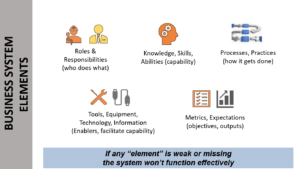Two Minutes on Manufacturing Excellence – The Power of Systems Thinking
It’s accurate to say that effective businesspeople routinely apply “thinking models” in their work and less effective businesspeople don’t. That’s a pretty sweeping generalization, but it holds up much of the time because thinking models consistently do two things.
- They promote and enable clear thinking, reason, analysis and collaboration that lead to good decision-making and positive results.
- They defeat our tendencies towards weak thinking that is often reactive, emotional and self-centric that lead to ineffective decision-making and poor results.
Anyone can be a good decision-maker
The good news is that these models can be applied by anyone who’s willing to learn them and apply them. Clear thinking and good decision-making aren’t so much a matter of “smarts” as it is a matter of “effective tools and methods” that are available to anyone.
Systems Thinking Basics
There are three practical and useful thinking models we’d like to discuss. In this article, and the next, we’ll consider one of those models called “Systems Thinking”.
We hear the term “systems” a lot. Edwards Deming famously observed that 93% of problems are caused by “the system” and 7% by “the person”. But what is “the system”? What is “system thinking”? And why is it so beneficial?
Systems and Business Systems
Generally speaking, a system is a bunch of parts working together to create an output. So, an automobile engine is a system. And on another level, the car itself is a system. OK, so what’s a “business system”?
 There are lots of systems in the workplace. We have training systems, production systems, continuous improvement systems, go-to-market systems, maintenance systems and more. And key to systems thinking is that, while the parts and pieces of each business system are different, the primary “elements” that comprise each of those systems are the same. They’re all made of the same following 5 elements:
There are lots of systems in the workplace. We have training systems, production systems, continuous improvement systems, go-to-market systems, maintenance systems and more. And key to systems thinking is that, while the parts and pieces of each business system are different, the primary “elements” that comprise each of those systems are the same. They’re all made of the same following 5 elements:
- Roles and Responsibilities (R&Rs) – Who does what
- Knowledge, Skills and Abilities (KSAs) – The capabilities to fulfill the R&Rs
- Work Processes – How work is done, both individually and collaboratively
- Enablers – Technology, equipment, information, etc. that support the work effort
- Expectations and Metrics – What’s expected and results (ideally quantifiable)
What’s the Value of System Thinking?
We’ll talk more about the how-to and the benefits of system thinking in the next article. For the moment, let’s just say that systems thinking enables us to:
- Ask the right questions
- Recognize “systematic weakness”, and
- Identify “systematic solutions” that often yield sustainable positive results
Exactly the things that effective businesspeople do!